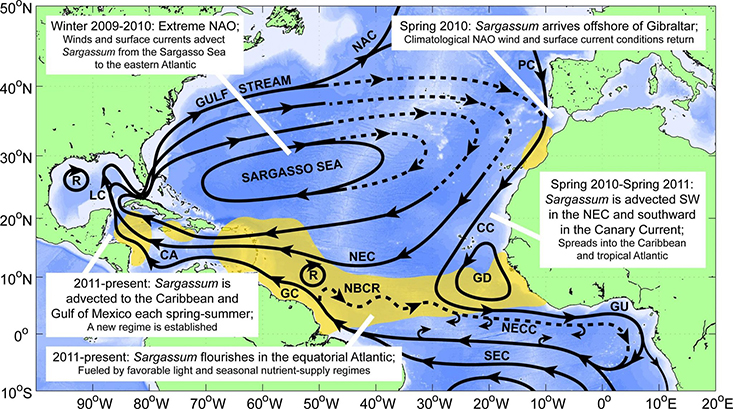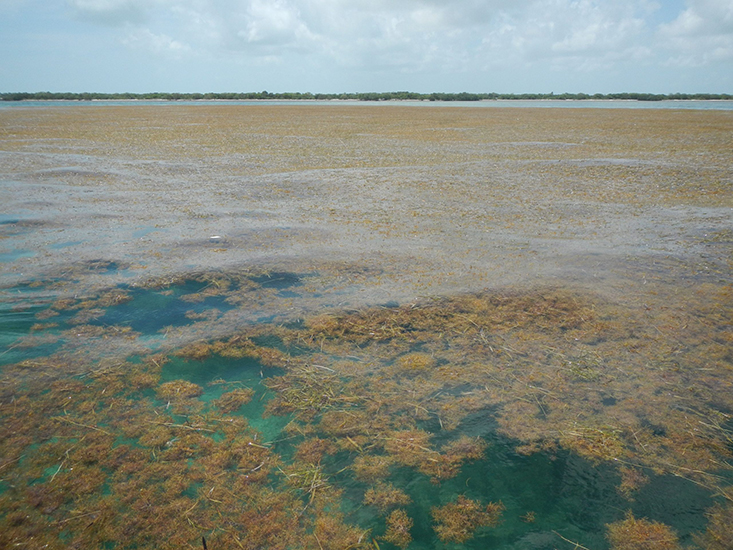Written by Kristen Kusek, Former Communications Director for USF CMS
ST. PETERSBURG, FL – Nearly every year since 2011, thick mats of Sargassum, a kind of brown algae, have blanketed the coastlines of many countries in Africa and the Americas. A new study in Progress in Oceanography, led by researchers at the National Oceanic and Atmospheric Administration (NOAA) and the University of South Florida College of Marine Science (USF CMS) sheds light on the mystery.
In historically “normal” amounts, Sargassum hosts a rich diversity of life, including other algae, crustaceans, fish, turtles, and birds in the area of the Atlantic Ocean called the Sargasso Sea – named after the algae – and the Gulf of Mexico. But the very high abundance of Sargassum in the tropical Atlantic, in areas 3,000 miles from the Sargasso Sea in some cases, is a new phenomenon—and too much can have adverse effects on coastal ecosystems. When it washes ashore the seaweed rots, attracts insects and repels beachgoers.
“The recurrence of this seaweed causes severe social and economic impacts on local communities, from Africa and the Caribbean to our shores in the USA,” said Dr. Libby Johns of NOAA’s Atlantic Oceanographic and Meteorological Laboratory (AOML) and lead author of the study.
The team analyzed reams of satellite data and used computer models of the Earth’s winds and ocean currents to try to understand why these large mats started to arrive in coastal areas in 2011. Here’s what they found:
During the winter of 2009-2010, the winds that typically blow from the Americas to Europe in the North Atlantic (called the westerlies) were stronger than usual, and the area of westerlies shifted to the south.
“This shift in the winds was unusual and had not been observed before at this strength and for such sustained periods,” said Frank Muller-Karger, a USF CMS professor, “and they triggered a long-distance dispersal of some of the Sargassum out of the Sargasso Sea. The winds and currents moved the Sargassum toward the Iberian Peninsula, then southward in the Canary Current along Africa, and it entered the tropics by the middle of the year 2010.
The tropical Atlantic provided ample sunlight, warmer sea temperatures, and nutrients for the Sargassum to flourish, and in 2011, the algae spread across the entire tropical Atlantic – wreaking havoc for many coastal nations in the region.
These blooms have appeared nearly every year since then.

This figure shows the hypothesized route that the Sargassum from the Sargasso Sea took to reach the tropical Atlantic and the Caribbean Sea. The solid black lines indicate the climatological surface flow, while the dashed black lines indicate areas where there was variability from the average conditions.
“We leveraged decades of archived data from the North Atlantic and the tropical Equatorial
Atlantic and mapped currents and winds, and gained new insight on the events that
began in 2009-2010. This helped us improve computer simulations to backtrack how the
seaweed reached the tropics from the Sargasso Sea,” said Dr. Rick Lumpkin, Deputy
Director of AOML’s Physical Oceanography Division.
The Sargassum seaweed now aggregates almost every year in April-May in a massive belt somewhat north of the Equator, along the Intertropical Convergence Zone or ITCZ (the ITCZ is a region where the trade winds converge, now also aggregating the Sargassum).
During the northern hemisphere spring, the Sargassum belt then drifts to the north following the seasonal northward excursion of the ITCZ. The belt stretches east to west across the entire central tropical Atlantic. Large portions of the algae are transported to the Caribbean and Gulf of Mexico via the North Equatorial and Caribbean current systems during this time.
“We gained insights from international oceanographic studies done in the Atlantic since the 1960s and from multiple satellite sensors. When we combined the Sargassum distribution patterns with these other types of data, we discovered that the trade winds aggregate the Sargassum under the ITCZ,” said Dr. Frank Muller-Karger.
The team also discovered that the strong trade winds mix the water deep enough to bring fresh nutrients to the surface and nourish the bloom.
“Some hypotheses attributed the Sargassum blooms to human activity in the Amazon River basin for the blooms, but now we think this has little to do with the formation of the bloom far offshore in the tropical Atlantic,” Muller-Karger said.
“Mapping the Sargassum from satellites is hard, but understanding it is even harder because multiple factors and nutrient sources may play different roles,” said Dr. Chuanmin Hu, a USF CMS professor whose team first discovered the massive algae belt last year using satellites. “This study has brought a new perspective about long-distance dispersal and open-ocean processes,” Hu said.
“Predicting the occurrence of Sargassum blooms will help us better understand their impacts on our ecosystems, and thereby improve our scientific advice in the management of valuable fisheries and protected species,” said Dr. Cisco Werner, Chief Science Advisor for NOAA National Marine Fisheries Service.
Additional studies are needed to fully understand and improve predictions of the distribution and impacts of Sargassum outbreaks, and to develop actions to effectively mitigate the invasions.
